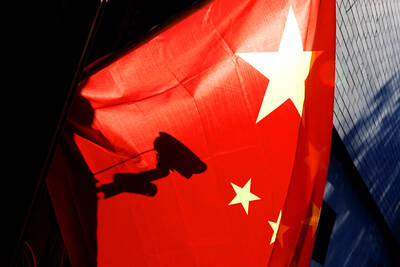The government’s decision to bring the defense budget to a five-year low is jeopardizing Taiwan-US military relations and future arms sales, and highlights longstanding questions about Taiwan’s commitment to self-defense, defense and foreign policy experts told a conference yesterday.
The Ministry of National Defense’s budget this year is NT$297.2 billion (US$9.2 billion), about 2.2 percent of GDP, despite a pledge by President Ma Ying-jeou (馬英九) to raise defense spending to 3 percent of GDP and calls from bipartisan -lawmakers to increase funding.
Less money in the budget has jeopardized defense projects and spending on new equipment and infrastructure, especially as the government moves to phase out conscription and implement an all-volunteer military.
Some military officials are admitting that a delay in the 2015 deadline for an all-volunteer force is in the works because of financial difficulties.
“There are officials in the US who are questioning Taiwan’s own defense commitment. And an important indicator of that is the defense budget — a method to clearly show the US Taiwan’s determination,” Joseph Wu (吳釗燮), Taiwan’s former representative to the US, told the conference in Taipei organized by the Taiwan Brain Trust think tank. “America’s willingness to strengthen Taiwan security ties is related to our own [commitment].”
At stake in the reduced defense budget, which has gradually been rolled back to 2006 levels as both a percentage of government spending and the total sum since a high of NT$349.5 billion in 2008, are the continued sales of large arms packages from the US to Taiwan.
Defense and foreign policy officials have for years lobbied for the sale of advanced F-16C/D multi-role fighter jets and diesel submarines, which were not included in the US$6.4 billion package announced by US President Barack Obama in January last year.
Military officials confirmed last week that they plan to axe a special fund set aside for the two items to a more “symbolic” figure of US$10 million.
Expressing concerns over such a move, former minister of national defense Michael Tsai (蔡明憲) said the decision would have far-reaching consequences for arms purchases over the next decade and the modernization of military hardware in the face of continued double-digit increases in the People’s Liberation Army’s budget.
Spurred in part by falling defense spending, but also the lack of a firm indication of any upcoming sales from the US, Tsai said the approach “will not only weaken Taiwan’s defense capabilities, but also deeply impact Taiwan-US military cooperation in the future.”
“Announcing only a symbolic figure for purchases of the [F-16C/Ds and diesel submarines] reveals a contradiction by President Ma, as he has previously advocated increased military spending of 3 percent of GDP annually ... this platform represents a shift in the balance of power across the Taiwan Strait,” Tsai said.
So far, there hasn’t been any indication from either defense or government officials on any major increases in military spending next year, amid generally warming ties with China.
Amid the reduced cross-strait tensions, there have been calls for the US to abandon Taiwan militarily, since there is a diminished chance of armed conflict with China, Wu said. Those calls have grown, not fallen, since Taiwan’s defense spending has been cut, Wu said, adding that Taiwan must showcase its commitment to self-defense.
In an article in the March/April edition of Foreign Affairs -magazine, Charles Glaser, a professor of international affairs at George Washington University, proposed abandoning Taiwan based on risks to the US by “ongoing improvements in China’s military capabilities [that] may make Beijing more willing to escalate a Taiwan crisis.”
While the rollback in defense spending has been gradual, it is significant when taken in the wider context of military funding by neighbors in the Asia-Pacific region.
Defense expert Su Tzu-yun (蘇紫雲) said Taiwan’s defense figure was especially sobering when compared with that in Singapore and South Korea.
Singapore, with one-fifth the population of Taiwan, spent US$9.5 billion on defense this year, with the gap between the two countries’ budgets expected to grow. South Korea and Australia spent US$25.9 billion and US$26.5 billion respectively, on their militaries this year, Su said, adding that this raised questions as to whether Taiwan faced any less of a threat.
“It doesn’t,” he said.
The balance of power against China, which spends 10 times as much on its military than Taiwan, “is skewed, and that invites aggression,” said Su, a former National Security Council researcher.
“The belief that economic cooperation prevents war is false,” he said, adding that despite improving cross-strait relations, Taiwan still needs to increase defense funding and press for more arms sales from the US — not just the F-16s — or it risked sending the wrong signal.

‘FORM OF PROTEST’: The German Institute Taipei said it was ‘shocked’ to see Nazi symbolism used in connection with political aims as it condemned the incident Sung Chien-liang (宋建樑), who led efforts to recall Democratic Progressive Party (DPP) Legislator Lee Kun-cheng (李坤城), was released on bail of NT$80,000 yesterday amid an outcry over a Nazi armband he wore to questioning the night before. Sung arrived at the New Taipei City District Prosecutors’ Office for questioning in a recall petition forgery case on Tuesday night wearing a red armband bearing a swastika, carrying a copy of Adolf Hitler’s Mein Kampf and giving a Nazi salute. Sung left the building at 1:15am without the armband and apparently covering the book with a coat. This is a serious international scandal and Chinese

SECURITY: As China is ‘reshaping’ Hong Kong’s population, Taiwan must raise the eligibility threshold for applications from Hong Kongers, Chiu Chui-cheng said When Hong Kong and Macau citizens apply for residency in Taiwan, it would be under a new category that includes a “national security observation period,” Mainland Affairs Council (MAC) Minister Chiu Chui-cheng (邱垂正) said yesterday. President William Lai (賴清德) on March 13 announced 17 strategies to counter China’s aggression toward Taiwan, including incorporating national security considerations into the review process for residency applications from Hong Kong and Macau citizens. The situation in Hong Kong is constantly changing, Chiu said to media yesterday on the sidelines of the Taipei Technology Run hosted by the Taipei Neihu Technology Park Development Association. With

A US Marine Corps regiment equipped with Naval Strike Missiles (NSM) is set to participate in the upcoming Balikatan 25 exercise in the Luzon Strait, marking the system’s first-ever deployment in the Philippines. US and Philippine officials have separately confirmed that the Navy Marine Expeditionary Ship Interdiction System (NMESIS) — the mobile launch platform for the Naval Strike Missile — would take part in the joint exercise. The missiles are being deployed to “a strategic first island chain chokepoint” in the waters between Taiwan proper and the Philippines, US-based Naval News reported. “The Luzon Strait and Bashi Channel represent a critical access

COUNTERINTELLIGENCE TRAINING: The ministry said 87.5 percent of the apprehended Chinese agents were reported by service members they tried to lure into becoming spies Taiwanese organized crime, illegal money lenders, temples and civic groups are complicit in Beijing’s infiltration of the armed forces, the Ministry of National Defense (MND) said in a report yesterday. Retired service members who had been turned to Beijing’s cause mainly relied on those channels to infiltrate the Taiwanese military, according to the report to be submitted to lawmakers ahead of tomorrow’s hearing on Chinese espionage in the military. Chinese intelligence typically used blackmail, Internet-based communications, bribery or debts to loan sharks to leverage active service personnel to do its bidding, it said. China’s main goals are to collect intelligence, and develop a